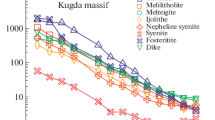Abstract
The REE distribution in minerals from tin-bearing ore-magmatic systems of the Russian Far East, including the Komsomolsk, Khingan, and Badzhal districts in the Amur region and the Kavalerovo, Lesozavodsk, Voznesenka, Furmanovo, and other districts in Primorsky krai, has been studied. The main attention was focused on tourmaline and chlorite; in addition, associated biotite, feldspar, apatite, fluorite, and carbonates were examined. The major factors affecting the REE distribution in the studied minerals are the temperature, Eh, and pH of the mineral-forming medium; crystal chemistry; partition coefficients of REE between fluid and minerals; and complexation that disturbs the coherent behavior of REE. Fluid evolution at different stages is characterized.
Similar content being viewed by others
References
M. Bau, “Rare-Earth Element Mobility during Hydrothermal and Metamorphic Fluid-Rock Interaction and the Significance of the Oxidation State of Europium,” Chem. Geol. 93, 219–230 (1991).
M. Bau, “Controls on the Fractionation of Isovalent Trace Elements in Magmatic and Aqueous Systems: Evidence from Y/Ho, Zr/Hf, and Lanthanide Tetrad Effect: A Discussion of the Article by M. Bau (1996),” Contrib. Mineral. Petrol. 128, 405–408 (1997).
J. Bor-Ming, E. Wu, R. Capdevila, et al., “Highly Evolved Juvenile Granites with Tetrad REE Patterns: the Woduhe and Baerzhe Granites from the Great Xing’an Mountains in NE China,” Lithos 59, 171–198 (2001).
N. S. Bortnikov and N. V. Gorelikova, “Trace Elements, REE and Fe2+/Fe3+ Distribution in Tourmaline and Chlorite from Tin Deposits of the Sikhote-Alin: Implications for Genesis of Tin Deposits,” in Proceedings of 12th IAGOD Symposium (Moscow, 2006).
N. S. Bortnikov, A. I. Khanchuk, T. L. Krylova, et al., “Geochemistry of the Mineral-Forming Fluids in Some Tin-Bearing Hydrothermal Systems of the Sikhote-Alin, the Russian Far East,” Geol. Rudn. Mestorozhd. 47(6), 537–570 (2005) [Geol. Ore Deposits 47 (6), 488–516 (2005)].
D. G. Brookins, “Eh-pH Diagrams for the Rare Earth Elements at 25°C and One Pressure,” Geochem. J. 17, 223–229 (1983).
D. G. Brookins, “Aqueous Geochemistry of Rare Earth Elements,” in Review in Mineralogy of Rare Earth Elements (1989), Vol. 21, pp. 201–225.
M. Cathelineau, “Cation Site Occupancy in Chlorites and Illites as a Function of Temperature,” Clay Miner. 23(4), 471–485 (1988).
M. Chaderi, J. M. Palin, I. H. Campbell, et al., “Rare Earth Element Systematic in Scheelite from Hydrothermal Gold Deposits in the Kalgoorlie-Norseman Region, Western Australia,” Econ. Geol. 94, 423–438 (1999).
V. G. Gonevchuk, Tin-Bearing Systems of the Russian Far East: Magmatism and Ore Formation (Dal’nauka, Vladivostok, 2002) [in Russian].
G. A. Gonevchuk and V. G. Gonevchuk, “Composition and Genesis of Intrusive Association of the Magloi Magmatic Areal, Central Amur Region,” Tikhookean. Geol. 27(1), 44–59 (2008).
V. G. Gonevchuk, B. I. Semenjak, A. I. Khanchuk, et al., “Tin-Bearing Magmatic Complexes of the Russian Far East,” in Mineral Deposits: Processes to Processing (Balkema, Rotterdam, 1999), Vol. 1, pp. 357–359.
N. V. Gorelikova, Microelement Assemblages of Tourmaline from Tin Deposits (Vladivostok, 1988) [in Russian].
W. Irber, “The Lanthanide Tetrad Effect and Its Correlation with K/Rb, Eu/Eu*, Y/Ho, and Zr/Hf of Evolving Peraluminous Granite Suites,” Geochim. Cosmochim. Acta 63(3/4), 489–508 (1999).
R. W. King and R. W. Kerrich, “REE Distribution in Tourmaline: An INAA Technique Involving Pretreatment by B Volatilization,” Am. Mineral. 73, 424–431 (1988).
P. G. Korostelev, V. G. Gonevchuk, B. I. Semenyak, et al., “The Solnechnoe Deposit (Komsomolsk Region, Khabarovsk krai) As a Type Object of Cassiterite-Silicate Ore,” in Ore Deposits of Continental Margins (Dal’nauka, Vladivostok, 2001), pp. 131–156 [in Russian].
B. G. Lottermoser, “Rare Earth Elements and Hydrothermal Ore Formation Processes,” Ore Geol. Reviews 7, 25–41 (1992).
J. W. Morgan and G. A. Wandless, “Rare Earth Element Distribution in Some Hydrothermal Minerals: Evidence for Crystallographic Control,” Geochim. Cosmochim. Acta 44(7), 973–980 (1980).
E. A. Radkevich, V. Ya. Asmanov, Yu. I. Bakulin, et al., Geology, Mineralogy and Geochemistry of the Komsomolsk Region (Nauka, Moscow, 1971) [in Russian].
I. T. Rass, S. S. Abramov, V. A. Utenkov, et al., “Role of Fluid in the Genesis of Carbonatite and Alkaline Rocks: Geochemical Evidence,” Geokhimiya 44(7), 692–711 (2006) [Geochem. Int. 44 (7), 636–655 (2006)].
Shao-Yong Jiang, Ji-Min Yua, and Jian-Jun Lua, “Trace and Rare-Earth Element Geochemistry in Tourmaline and Cassiterite from the Yunlong Tin Deposit, Yunnan, China: Implication for Magmatitic-Hydrothermal Fluid Evolution and Ore Genesis,” Chem. Geol. 209, 193–213 (2004).
T. M. Sushchevskaya and B. N. Ryzhenko, “Simulation of Mixing of Fluids from Different Sources during Cassiterite Precipitation,” Geokhimiya 40(2), 184–193 (2002) [Geochem. Int. 40 (2), 155–163 (2002)].
D. A. Sverjensky, “Europium Redox Equilibria in Aqueous Solutions,” Earth Planet. Sci. Lett. 67, 70–78 (1984).
L. V. Veksler, A. M. Dorfman, M. Kamenetsky, et al., “Partitioning of Lanthanides and Y between Immicible Silicate and Fluoride Melts, Fluorite and Cryolite and the Origin of the Lanthanide Tetrad Effect in Igneous Rocks,” Geochim. Cosmochim. Acta 69(11), 2847–2868 (2005).
V. A. Zharikov, N. S. Gorbachev, W. Doherty, et al., “Fractionation of Rare Earth Elements and Yttrium in Fluid-Magmatic Systems under a High Pressure: Experimental Data,” Geokhimiya 331(1), 91–94 (1993).
Author information
Authors and Affiliations
Corresponding author
Additional information
Original Russian Text © N.S. Bortnikov, N.V. Gorelikova, P.G. Korostelev, V.G. Gonevchuk, 2008, published in Geologiya Rudnykh Mestorozhdenii, 2008, Vol. 50, No. 6, pp. 507–525.
Rights and permissions
About this article
Cite this article
Bortnikov, N.S., Gorelikova, N.V., Korostelev, P.G. et al. Rare earth elements in tourmaline and chlorite from tin-bearing assemblages: Factors controlling fractionation of REE in hydrothermal systems. Geol. Ore Deposits 50, 445–461 (2008). https://doi.org/10.1134/S1075701508060032
Received:
Published:
Issue Date:
DOI: https://doi.org/10.1134/S1075701508060032




